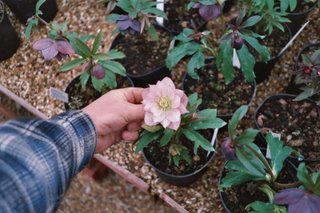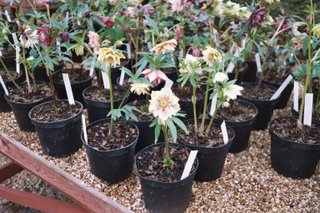We have always grown a wide range of hardy Fuchsias and despite a sterling effort at making a hash of it the RHS have come up with some interesting new awards after trialling. We have acquired stock of a number of these and we will be propagating them in small quantities this year. If you are interested in this group of plants the please let us know and we can make sure you get some to try out. Despite the overwhelming availability of Fuchsia plugs we maintain that there is still a good justification for a our robust liner that will require little work and a minimum of protection to produce a flowering plant
Orthrosanthus laxus is a perennial that has Wedgewood blue, starry flowers over iris like leaves. Grows and flowers without protection. 45-60cm
Molinia Skyracer is a grass to be grown as a specimen plant – I have seen it flower with the spikes reaching over three metres (although the books give it as only 2.5m). Like all Molinias it is completely herbaceous, but comes back to make a large clump of relatively broad leaves before the flower spikes appear.
Iris Sibirica hybrids produce flowers in a range of shades of blue from very pale to almost black, all marked with conspicuous veining and white bases to the falls. Height from 60-90cm.
Whenever we have Embothrium on offer I make the point that they cannot be grown in a standard compost: they will die as they are super efficient at extracting phosphate from their substrate and they will take up a lethal amount. Please ask for more information if you want to grow this very popular small tree which has fire-coloured flowers in late spring.
Corylus avellana ‘Aurea’ and Corylus maxima ‘Purpurea’ are both spectacular shrubs which respond best to being cut down hard each winter to maximise the size of the yellow and purple (respectively) leaves. The drawback to this is that you the don’t get many of the catkins which in both cases are particularly large and coloured like the leaves, so an alternative pruning regime is to only cut out half the current growth each year, but all the two year shoots which should have flowered. If left unpruned both become very large shrubs.
Although Lupinus arboreus and Lupinus chamissonis are relatively short-lived they are both worthwhile plants and will perpetuate themselves by seed. L. chamissonis is more compact than the L.arboreus and has finer leaves which are slightly hairy and give a silvery sheen to the plant; the flowers are blue with white keels. We are temporarily out of the yellow (species) form of L.arboreus but there will be more available soon and we also will have some white and some progeny from the variety ‘Barton on Sea’ which have a pinky tinge on yellow.
We have been impressed with the habit of Lotus hirsutus ‘Lois’ which is more spreading and branched than the rather upright type. Both have small, grey, trifoliate leaves which are intensely hairy giving the plant a very silvery appearance. Flowers are pea-like and pink, and can be followed by dark red, shiny seed pods. Lotus has a delicate appearance, which belies its hardiness and resilience although in pots it will defoliate if it gets too wet.
Arum italicum Marmoratum is an awkward plant in the nursery because it is summer dormant with its sagittate (arrow-shaped) grey-marbled leaves re-appearing in the autumn and lasting through the winter. Spathoid flowers appear in spring followed by ‘Lord and Ladies’ spikes of berries in the summer when the leaves are absent. Although the native types frequently grow under trees Arum Marmoratum should be planted in sun.
And finally for the benefit of climber growers who have waded through this far; have you ever tried Muehlenbeckia? The species has small round leaves while the form ‘Trilobata’ has three lobed leaves which subtly changes the look of the plant. Both are sprawling plants which, with support, will cover anything. The wiry stems are dark so the whole effect is dark, which in autumn is lightened by tiny, cream waxy flowers. It is certainly hardy in this part of the country and can be rampant in the south-west.







